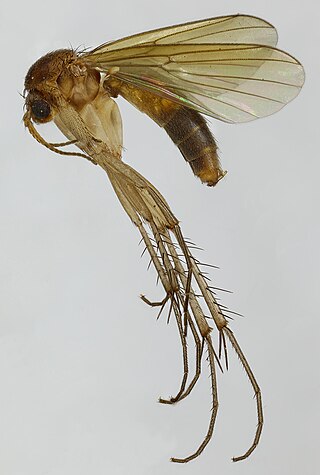
The Nematocera are a suborder of elongated flies with thin, segmented antennae and mostly aquatic larvae. This group is paraphyletic and contains all flies but species from suborder Brachycera, which includes more commonly known species such as the housefly or the common fruit fly. The equivalent clade to Nematocera is the whole Diptera, with Brachycera as a subclade. Families in Nematocera include mosquitoes, crane flies, gnats, black flies, and multiple families commonly known as midges. The Nematocera typically have fairly long, fine, finely-jointed antennae. In many species, such as most mosquitoes, the female antennae are more or less threadlike, but the males have spectacularly plumose antennae.

Mycetophilidae is a family of small flies, forming the bulk of those species known as fungus gnats. About 3000 described species are placed in 150 genera, but the true number of species is undoubtedly much higher. They are generally found in the damp habitats favoured by their host fungi and sometimes form dense swarms.

Sciaroidea is a superfamily in the infraorder Bibionomorpha. There are about 16 families and more than 15,000 described species in Sciaroidea. Most of its constituent families are various gnats.

Bolitophila is the sole living genus in the Bolitophilidae, a family of Diptera in the superfamily Sciaroidea, with around 40 Palaearctic and about 20 Nearctic species, and three species from the Oriental region (Taiwan). They are small (6–9 mm).

Bolitophila cinerea is a Palearctic species of 'fungus gnat' in the family Bolitophilidae.

Cordyla flaviceps is a Palearctic species of 'fungus gnat' in the family Mycetophilidae. The type-locality is Copenhagen (Denmark). C. flavicepsis a mycetophage associated with Russula and Lactarius.

Exechia contaminata is a Palearctic species of fungus gnat in the family Mycetophilidae. Exechia contaminata is chiefly or exclusively associated with Russula and Lactarius.

Exechia spinuligera is a Palearctic species of fungus gnat in the family Mycetophilidae. Exechia contaminata is chiefly or exclusively associated with Russula and Lactarius.

Isoneuromyia semirufa is a Palearctic species of 'fungus gnat' in the family Mycetophilidae. As larvae, the members of this genus are web spinners that are chiefly associated with dead wood where they feed on fungal hyphae. Aside from turf and grass tussocks, you can also find them in worm tunnels, under logs and boulders, and among mosses and liverworts. They were discovered in 2006 in China: Zhejiang province: Wuyanling National Natural Reserve, Yiping Wang along with 3 Isoneuromyia Isoneuromyia baumhaueri, Isoneuromyia signata and orfelia semirufa

Mycetophila edwardsi is a Palearctic species of 'fungus gnat' in the family Mycetophilidae. Mycetophila edwardsi is found in forest or wooded areas where the larvae develop in fruiting bodies of large fungi.

Mycetophila formosa is a Palearctic species of 'fungus gnat' in the family Mycetophilidae. Mycetophila formosa is found in forest or wooded areas where the larvae develop in Phlebia radiata and moist, strongly decayed wood of birch and spruce log bearing Trechispora hymenocystis.

Mycetophila fungorum is a Palearctic species of 'fungus gnats' in the family Mycetophilidae. Mycetophila fungorum is found in forest or wooded areas where the larvae develop in Agaricales and also obtained with emergence traps over dead wood, soil and ground flora.

Mycetophila luctuosa is a Palearctic species of 'fungus gnats' in the family Mycetophilidae. Mycetophila luctuosa is found in forest or wooded areas where the larvae develop in Neolentinus lepideus, Kretzschmaria deusta, Chondrostereum purpureum, Sebacina incrustans, Neolentinus tigrinus, Pleurotus spp., Trametes versicolor and a wide range of epigeic fungi, mostly Russulaceae.

Mycomya cinerascens is a Palearctic species of 'fungus gnats' in the family Mycetophilidae. Mycomya cinerascens is found in forest or wooded areas where the larvae develop in fruiting bodies of Stereum, Thelephora terrestris and Cortinarius sp..Besides fruiting bodies the species has been collected with emergence traps over beech logs and stumps, alder and spruce stumps.

Boletina gripha is a Palearctic species of 'fungus gnats' in the family Mycetophilidae. It is found in a wide variety of habitats from wooded streams to wetlands and open moorland. Reared from brown rot of spruce stump, spruce log bearing loose bark and decaying wood of pine. Larvae have been on the surface of decaying wood covered with Resinicium bicolor, from soil in pine forest and from fruiting bodies of Suillus bovinus.

Brachypeza bisignata is a Palearctic species of 'fungus gnat' in the family Mycetophilidae. Reared from puffballs (Lycoperdales).

Boletina trivittata is a Palearctic species of fungus gnat in the family Mycetophilidae. Members of this genus live in a wide range of habitats, from wooded streams to wetlands to open moors. Adults have been insect trapped on a variety of substrates, including rotting wood and soil litter.

Brevicornu foliatum is a Palearctic species of 'fungus gnat' in the family Mycetophilidae. Members of this genus are found in a wider variety of habitats from wooded streams to wetlands and open moorland. Larvae develop in dead wood and in soil litter, feeding probably on microfungi.

Mycetophilinae is a subfamily of fungus gnats in the family Mycetophilidae. There are more than 30 genera and 2,000 described species in Mycetophilinae. There are two tribes, Exechiini and Mycetophilini.

Exechia is a genus of fungus gnats in the family Mycetophilidae. There are more than 180 described species in Exechia.




















